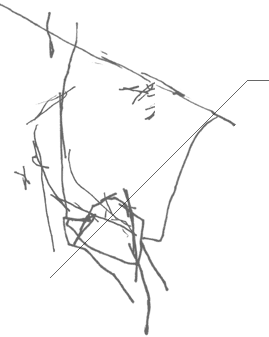Thursday, January 1, 2026 |
||

|

by Michael Goldberg
Monday, February 25, 2002
Deciphering The Code
Boards of Canada and ...And You Will Know Us by the Trail of Dead offer a musical yin/yang that will blow your mind
|
|||
|
The rain is coming down, and on either side of the highway are green fields. Rising from them, with a backdrop of mountains receding into the distance, are numerous metal towers, with wires strung between them. The sky is all dark clouds. I'm driving and this is the vision before me. It's beautifully ominous, like one of those scenes at the abandoned plant in an early-'60s comic book where lightning is about to meet radioactive waste and the result will be something... awful. This is the "movie" I'm screening as Source Tags & Codes,the new album by ...And You Will Know Us by the Trail of Dead, rocks loud and hard from my car stereo.
Later, red bleeds into oranges and yellows. I'm in my house, staring at the trippy cover of the long-awaited Boards of Canada album, Geogaddi,which looks like it was photographed through a kaleidoscope. A figure appears to be dancing. There are trees. The figure and the trees are repeated, in a circle, six times. Déjà vu: This looks like psychedelic 1965 all over again. Look at this image long enough and you can almost feel the acid kick in. These two albums are opposites, one yin to the other's yang. Souce Tags & Codesstares down the world; Geogaddiis a meditation, a journey to the center of your being. Source Tags...is dramatic, explosive. Geogaddisoothes with its repetitions. Source Tags...' rock lineup of guitars/bass/drums/vocals pushes aside everything in its path. The loops, electronic rhythms, organ tones and found sounds of Geogaddiwelcome you: relax, lie on some pillows, smell the incense, take a sip of this.... Rock is the operative word here. Souce Tags & Codesmay just be the best pure rock album since At the Drive-In's Relationship of Command.It's a big album. In scope, think Zeppelin, think Metallica. I hate to bring up Nirvana or Sonic Youth, 'cause this sounds nothing like them, yet it reminds me of Nevermindand Evolin the way that when you heard those albums, you knew what you were hearing was important. Geogaddicomes four years after Boards of Canada's Music Has the Right to Children.Many have waited and waited for this album. They will not be disappointed. I am no electronic music expert, but I've been reading lately that much electronic music has reached a dead end. Anyone with a laptop and some software can make a "glitch" record. It's all gotten very mathematical and soulless. Many were greatly disappointed by the most recent Aphex Twins album, Drukqs,and though I dug the last Squarepusher, Go Plastic,others didn't. ...And You Will Know Us... — Jason Reece, Conrad Keely, Neil Busch and Kevin Allen — formed in 1994; what they most remind me of is the long-departed original MX-80 Sound from Bloomington, Ind. (MX-80, and also At the Drive-In.) Something about some of the chord changes and song structures. MX-80 didn't rock this hard (at least on record), but there was an intelligence coupled with a disturbing feel in the music that makes those bands cousins twice removed. Unlike some of the recent electronic albums, there's nothing soulless about Geogaddi.When Edinburgh, Scotland's Boards Of Canada — Michael Sandison and Marcus Eoin — released Music Has the Right to Childrenin 1998, they presented the world with something new. True, they had begun making recordings in 1989 and spent years developing the sound of Music Has the Right to Children,but for many of us, that album was our first contact with BOC. What we got was a fully realized sonic world — one that's constructed from bits and pieces of our current reality, but sounds like an alternative. They continue to inhabit their world, and Geogaddicould be viewed as Music Has the Right...Part Two.Only it strikes me as even stronger, more subtly intense and compelling, if that's even possible. "Scientific psychedelic music" is what they call their current work, and if you need a tagline, that's as good as any. The wiry guitar lines of Source Tags...are like those wires traversing the sky below the clouds. Guitar sounds caress the ears, then explode in huge sonic waves. In one of my favorites, "How Near, How Far," the music quiets and the guitar is delicate, yet still ominous, then builds and builds, with Conrad Keely (just one of the members who sings) repeating: "How near, how far, how long..." Dig the way BOC - they say their name comes from spending some time in Canada, and liking the documentaries produced by the National Film Board of Canada -- create an ominous mood from a machine-like beat, organ tones and a muffled voice counting off numbers in "Gyroscope." A synth (or is it some old analog keyboard) tone in "Sunshine Recorder," over a stuttering rhythm, does sound to me like a recording of sunshine. A standout is "1969," which trips to a skip-along beat, as music swirls through the air, and a voice speaks in tongues before it is joined by additional robotic voices that chant "1969 in the sunshine." Both of these albums, in their own way, could 'cause you to rethink your life. You could drift away. You could start walking and never come back. You could get in a car and just drive. Anywhere, really. You could lose yourself in your musings. Get lost in the depths of your mind. Lose consciousness. Enter some alterna-consciousness. Fall under a spell. Decide to quit your job and join the Peace Corps. Renounce this world. Listen to these albums for too long and there's no telling.... |
||||